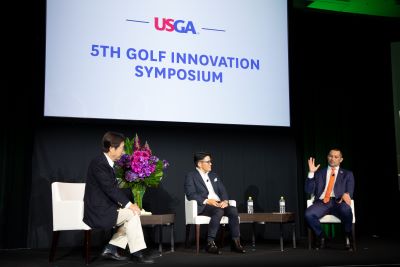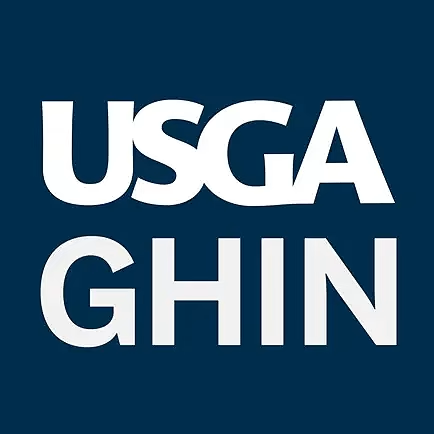
“The USGA Golf Innovation Symposium demonstrated that no matter where golf is played, there are plenty of common challenges as well as opportunities for making the game stronger and more sustainable,” said Tsunetada Takeda, chairman of the JGA. “The USGA has shown the path forward for using data and technology to bring much-needed solutions to the industry.”
LIBERTY CORNER, N.J. (April 1, 2019) – Following a successful two-day summit in Tokyo that elevated the latest global research in golf participation and sustainability, the USGA has released key findings from its fifth Golf Innovation Symposium, presented by Cisco.
Supported by the Japan Golf Association (JGA), the USGA brought together dozens of experts from around the world to advance its challenge statement to improve golfer satisfaction by 20 percent and reduce the consumption of key resources by 25 percent before 2025. The overwhelming support for the challenge statement underpinned the sessions, which focused on improving golfer experience and satisfaction, providing playing opportunities for all who wish to enjoy the game, and fostering innovation, productivity and efficiency among golf facilities.
“The USGA Golf Innovation Symposium demonstrated that no matter where golf is played, there are plenty of common challenges as well as opportunities for making the game stronger and more sustainable,” said Tsunetada Takeda, chairman of the JGA. “The USGA has shown the path forward for using data and technology to bring much-needed solutions to the industry.”
Select video presentations, as well as speaker biographies and summaries, can be viewed at usga.org/symposium.
NOTE TO EDITORS: PHOTO SELECTIONS FROM THE 2019 GOLF INNOVATION SYMPOSIUM CAN BE FOUND HERE.
Golfer Experience, Satisfaction and Opportunity
Participation remains at the top of the golf industry’s list of priorities. Primary research conducted for the symposium provides direction for all facilities to better attract and retain golfers.
Attracting New Golfers
Results of surveys conducted prior to the symposium reveal insights and potential strategies for introducing the game to non-participants:
- Why people don’t play – Shigeki Mitsuishi of Yano Research highlighted cost as the biggest barrier to participation in Japan.
- How golfers start playing – Yano Research also revealed that nearly two-thirds of existing golfers in Japan took up the game through a business contact or friend, and that more than 90 percent had their first golf experience at a driving range or short course.
- Satisfaction with short courses – In research conducted for the French Golf Federation, which spearheaded an effort to build 100 short-course facilities in France over the past 11 years, Sports Marketing Surveys determined that these facilities scored highest in offering a welcoming atmosphere and providing good value – the two most important factors among customers. Between 2009 and 2018, these facilities recorded more than 80,000 newly “licensed” golfers, more 17,000 of whom were new golfers.
- Simulators as an entryway to the game – According to GOLFZON, which has installed more than 5,700 simulators in the Republic of Korea, nearly 80 percent of “screen golf” participants have played golf on a green-grass course.
Retaining Current Golfers
No matter the country, measuring and improving golfer satisfaction is a key to the long-term health of the game.
- Identifying the factors that impact experience – In Japan as in the U.S., there is a fundamental perception gap between what golfers value during a round of golf and what facility managers believe golfers value. The symposium revealed that facility managers underestimate the importance of factors such as distance to the course, course yardage and ease of making a reservation, while facility managers overestimate factors such as service and pro shop selection.
- Reasons for playing the game – Golfer experience conducted by the University of Wisconsin-Stout for the USGA revealed that the top three reasons – by far – for playing golf are love of the game, spending time with family/friends and a desire to improve.
- Measuring golfer experience – During the symposium, the USGA, JGA and research program Players 1st announced a pilot program in Japan for using Players 1st to measure experience and satisfaction at several clubs throughout the country.
- Elite player experience – Data collection at the U.S. Junior Amateur showed that a one-minute increase in starting-time intervals resulted in improvements in round times of nearly 20 minutes between 2016 and 2018.
Facility Innovation and Productivity
The cost of operating a golf facility and maintaining courses remain issues for the golf industry, and the symposium presented innovations in several areas.
Resource Management
The USGA demonstrated two case studies for the USGA GPS Service – one at Kasumigaseki Country Club, site of the golf competition for the 2020 Olympic Games, the other at Crandon Park, a course owned and operated by Miami-Dade County in Florida.
- At Kasumigaseki Country Club, the heat maps generated through the data collected by GPS loggers using the USGA facility tool showed several areas for maintenance efficiency, including the possible removal of bunkers.
- At Crandon Park, course architect John Sanford used the heat maps to identify more than 40 acres of turf that are being converted in his proposed redesign of the course. The potential financial impact of this redesign is an annual reduction of water costs of more than $350,000.
Facility Sustainability and Innovation
The USGA brought together innovators to showcase ideas, best practices and case studies that help facility managers and golf administrators to improve their operational and maintenance efficiency.
- Nobuya (Mike) Ishizaka, CEO of Golf Digest Online, shared analysis of data accumulated by his company’s tee-time reservation system that can improve sell-through rates and raise average green fees by more than $30.
- Jeff Blume, president of the American Society of Golf Course Architects, shared survey results in which 47 percent of private facilities and 39 percent of public facilities in the U.S. report that course renovations can help increase usage of their facilities.
- Hamanako Country Club in Japan initiated a solar- and wind-power generation program that reduces 1,250 tons of CO2 emissions annually and is expected to result in a positive return on investment in 16 years.
- Golf Australia’s consolidation of its golf administration operations at the national level resulted in the addition of 14,000 members and the reinvestment of $4 million into programs.
For more information about the USGA’s Golf Innovation Symposium, recent research and biographies of presenters, please see usga.org/symposium.
About the USGA
The USGA celebrates, serves and advances the game of golf. Founded in 1894, we conduct many of golf’s premier professional and amateur championships, including the U.S. Open and U.S. Women’s Open. With The R&A, we govern the sport via a global set of playing, equipment and amateur status rules. Our operating jurisdiction for these governance functions is the United States, its territories and Mexico. The USGA Handicap System is utilized in more than 40 countries and our Course Rating System covers 95 percent of the world’s golf courses, enabling all golfers to play on an equitable basis. The USGA campus in Liberty Corner, New Jersey, is home to the Association’s Research and Test Center, where science and innovation are fueling a healthy and sustainable game for the future. The campus is also home to the USGA Golf Museum, where we honor the game by curating the world’s most comprehensive archive of golf artifacts. To learn more, visit usga.org.














